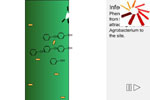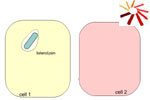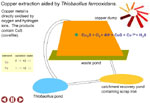Animaciones de biología ( Muy bueno, nivel alto)
Enciclopedia of life
RECURSOS DEL MNISTERIO DE EDUCACIÓN Y CIENCIA. LIBROS DIGITATLES QUE SE
PUEDEN DESCARGAR
Biología Mcgraw-hill (Nivel alto)
 |
CHAPTER ANIMATIONS View full color, dynamic animations to help you visualize key biological processes. You have the ability to control the animation by turning on or off the narration, playing the animation with or without text, and can start, stop, or rewind the animation to any point you choose. Click on a Chapter Link below to view an Animation, a new window will pop up. To return to this menu, close the chapter animation window when finished. |
| Chapter 5 -Lysosomes Chapter 6 - Sodium-Potassium Exchange Pump - Cotransport - Endocytosis and Exocytosis - Proton Pump Chapter 7 - How Intracellular Receptors Regulate Gene Transcription - Second Messengers - The cAMP and Ca Pathways - Signal Amplification Chapter 8 - A Biochemical Pathway - Feedback Inhibition of Biochemical Pathways Chapter 9 - Electron Transport System and ATP Synthesis Chapter 10 - Cyclic and Noncyclic Photophosphorylation - Photosynthetic Electron Transport and ATP Synthesis Chapter 11 - Mitosis and Cytokinesis - Cell Proliferation Signaling Pathway - Bidirectional Replication of DNA - Unique Features of Meiosis Chapter 12 - Comparison of Meiosis and Mitosis - Random Orientation of Chromosomes During Meiosis - Stages of Meiosis Chapter 14 - Hershey and Chase Experiment - Meselson and Stahl Experiment - DNA Replication Fork - How Nucleotides are Added in DNA Replication Chapter 15 - Processing of Gene Information - Prokaryotes versus Eukaryotes - Protein Synthesis - How Spliceosomes Process RNA Chapter 16 - Restriction Endonucleases - Restriction Fragment Length Polymorphisms - Early Genetic Engineering Experiment - Constructing Vaccines - Southern Blot - cDNA - Steps in Cloning a Gene - Polymerase Chain Reaction - Microarray - The Ti Plasmid Chapter 18 - The Tryptophan Repressor - Combination of Switches - the Lac Operon - Control of Gene Expression in Eukaryotes - Transcription Complex and Enhancers Chapter 20 - Integration and Excision of a Plasmid - Mechanism of Transposition - The Consequence of Inversion - Control of the Cell Cycle - Slipped-strand Mispairing - Conjugation with F Plasmid - Thymine Dimers - How Tumor Suppressor Genes Block Cell Division Chapter 21 - The Consequence of Inversion Chapter 26 - Treatment of HIV - How Prions Arise - HIV Replication Chapter 28 - Malaria - Life Cycle of Plasmodium Chapter 42 - Sarcomere Shortening Chapter 43 - Three Phases of Gastric Secretion Chapter 44 - Changes in the Partial Pressures of Oxygen and Carbon Dioxide Chapter 45 - Chemical Synapse - Membrane-Bound Receptors G Proteins and Ca2 Channels - Voltage Gated Channels and the Action Potential - Sodium-Potassium Exchange - Action Potential Propagation in an Unmyelinated Axon - Function of the Neuromuscular Junction Chapter 46 - Effect of Sound Waves on Cochlear Structures Chapter 47 - Mechanism of Steroid Hormone Action - Mechanism of Thyroxine Action - Action of Epinephrine on a Liver Cell Chapter 48 - Cytotoxic T-cell Activity Against Target Cells - Interaction of Antigen Presenting Cells and T-helper Cells - Monoclonal Antibody Production - IgE Mediated Hypersensitivity Chapter 50 - Spermatogenesis These 106 in-depth tutorials are designed to illustrate and explain some of the many complex topics in biology. Each tutorial has four elements: an introduction that describes the topic to be illustrated and puts it into a broader context, a detailed animation that clearly illustrates the topic (there are a few tutorials that include simulations or other types of content, rather than animations), a conclusion that summarizes what you should have learned from the animation, and a quiz on the topic covered. The clear presentation of complex topics make these tutorials a powerful learning tool, be sure to work through them in their entirety for the best benefit. New to the Seventh Edition are 20 Key Experiment tutorials that expand upon some of the most important experiments depicted in the book, as well as 10 additional new tutorials. All the animated activities include textbook references, making it easy for you to look up a topic in the text for further explanation. For details on how the tutorials work, click the Help button on the Animation tab of a tutorial. Note: An 'E' indicates an experiment tutorial. These correspond to experiment figures in the textbook. Chapter 1: An Evolutionary Framework for Biology PART ONE The Cell Chapter 2: Life and Chemistry: Small Molecules Chapter 3: Life and Chemistry: Large Molecules
Chapter 5: Cellular Membranes
Chapter 7: Cellular Pathways That Harvest Chemical Energy
PART TWO Information and Heredity Chapter 10: Genetics: Mendel and Beyond
Chapter 14: The Eukaryotic Genome and Its Expression Chapter 15: Cell Signaling and Communication Chapter 16: Recombinant DNA and Biotechnology Chapter 17: Molecular Biology and Medicine Chapter 18: Natural Defenses against Disease
Chapter 19: Differential Gene Expression in Development
Chapter 21: Development and Evolutionary Change PART FOUR Evolutionary Processes Chapter 22: The History of Life on Earth Chapter 23: The Mechanisms of Evolution
Chapter 25: Reconstructing and Using Phylogenies Chapter 26: Molecular and Genomic Evolution PART FIVE The Evolution of Diversity Chapter 27: Bacteria and Archaea: The Prokaryotic Domains Chapter 28: Protists and the Dawn of the Eukarya
Chapter 30: The Evolution of Seed Plants Chapter 31: Fungi: Recyclers, Pathogens, Parasites, and Plant Partners Chapter 32: Animal Origins and the Evolution of Body Plans Chapter 33: Ecdysozoans: The Molting Animals Chapter 34: Deuterostomate Animals PART SIX The Biology of Flowering Plants Chapter 35: The Plant Body Chapter 36: Transport in Plants Chapter 37: Plant Nutrition Chapter 38: Regulation of Plant Growth
Chapter 40: Plant Responses to Environmental Challenges PART SEVEN The Biology of Animals Chapter 41: Physiology, Homeostasis, and Temperature Regulation Chapter 42: Animal Hormones
Chapter 44: Neurons and Nervous Systems
Chapter 47: Effectors: Making Animals Move Chapter 48: Gas Exchange in Animals Chapter 49: Circulatory Systems Chapter 50: Nutrition, Digestion, and Absorption Chapter 51: Salt and Water Balance and Nitrogen Excretion Chapter 52: Animal Behavior
Chapter 53: Behavioral Ecology Chapter 54: Population Ecology
Chapter 56: Biogeography Chapter 57: Conservation Biology Biology & Life Science Animations |

















































